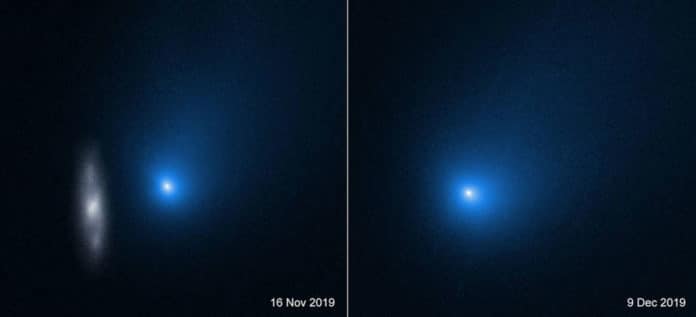2I/Borisov is the first observed interstellar comet, and the second observed interstellar interloper after ʻOumuamua’. It has 14 times the size of Earth with diameter ranged from 1.4 km to 16 km.
The comet 2I/Borisov traveled through the solar system in late 2019. It did not come much closer to Earth than 300 million km.
For the first time, NASA’s Neil Gehrels Swift Observatory tracked water loss from an interstellar comet as it approached and rounded the Sun.
Amateur astronomer Gennady Borisov discovered the comet on August 30, four months before it made its closest approach to the Sun. The early identification gave multiple space- and ground-based observatories time for detailed follow-up observations. In October, scientists using the Apache Point Observatory in Sunspot, New Mexico, detected the first hint of water from the comet. In the following months, NASA’s Hubble Space Telescope snapped images of Borisov as the comet sped along at around 100,000 miles (161,000 kilometers) per hour.
As a comet approaches the Sun, frozen material on its surface — such as carbon dioxide — warms and begins converting to gas. When it gets within 230 million miles (370 million kilometers) of the Sun, water vaporizes.
When sunlight breaks apart water molecules, one of the fragments is hydroxyl, a molecule composed of one oxygen and one hydrogen atom. Swift detects the fingerprint of UV light emitted by hydroxyl using its Ultraviolet/Optical Telescope (UVOT). Between September and February, Xing’s team made six observations of Borisov with Swift. They saw a 50% increase in the amount of hydroxyl — and therefore water — Borisov produced between Nov. 1 and Dec. 1, which was just seven days from the comet’s closest brush with the Sun.
Zexi Xing, a graduate student at the University of Hong Kong and Auburn University in Alabama who led the research said, “During its trip through the solar system, the comet lost nearly 61 million gallons (230 million liters) of water — enough to fill over 92 Olympic-size swimming pools. As it moved away from the Sun, Borisov’s water loss dropped off — and did so more rapidly than any previously observed comet. This could have been caused by a variety of factors, including surface erosion, rotational change, and even fragmentation. Data from Hubble and other observatories show that chunks of the comet broke off in late March.”
Co-author Dennis Bodewits, an associate professor of physics at Auburn, said, “We’re delighted that Swift’s rapid response time and UV capabilities captured these water production rates. For comets, we express the amount of other detected molecules as a ratio to the amount of water. It provides a vital context for other observations.”
Journal Reference:
- Water Production Rates and Activity of Interstellar Comet 2I/Borisov. DOI: 10.3847/2041-8213/ab86be
